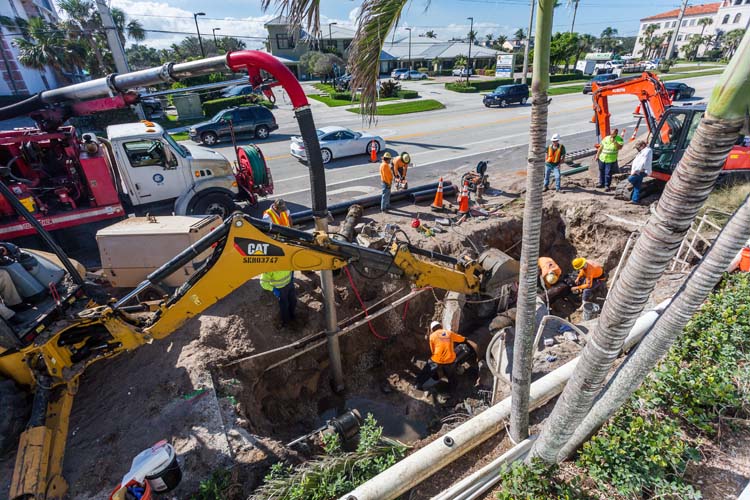
The City of Vero Beach last week completed final repairs to the sewer main that drains much of the northern part of the barrier island. The rusting 50-year-old iron pipe ruptured in November, dumping 3.1 million gallons of raw sewage into Bethel Creek before temporary repairs halted the spill.
The city had to wait for seasonally high tides to recede – they last from October through December – before undertaking the complex repair. Even with the water table lower, the site required dewatering for work to proceed last Thursday and Friday. The break was on the east side of State Road A1A, in front of the newly-built Surf Club townhomes, near Jaycee Park.
Residents were asked to limit water usage while the line, which carries waste to the city’s sewage treatment plant, was cut for repair. At the same time, 30 lift stations were shut off between Jaycee Park and the north boundary of Indian River Shores, from about 8 a.m. to 5 p.m. on Thursday to reduce the flow of sewage.
Vero Water and Sewer Department Director Rob Bolton said the city hired Meeks Plumbing to run three pump trucks to suck up the waste water accumulating at closed lift-stations to prevent sewage from backing up into businesses and homes.
About 25 feet of 12-inch iron pipe was cut away and replaced with the same material and then a protective sleeve, also of iron, was installed where the sewage pipe runs through a large concrete stormwater drain. The break was probably caused by the storm water pipe, which encased the sewer pipe in corrosive salty water, but Bolton is sending the pipe away for analysis to nail down the cause.
“Everything was back online before 5 o’clock, before people got home,” Bolton said “The highest water usage – 60 percent – is between 5 p.m. and 9 p.m.”
The spill came to light on Nov. 16 when residents complained of a foul odor along Bethel Creek, an inlet that connects to the lagoon near the city marina north of the Barber Bridge.
After a reporter called the city to check on the cause of the smell, Bolton investigated and discovered the broken line.
At that time, he estimated 100,000 gallons of sewage had spewed into the lagoon, but after checking flow records at the sewage plant he upped the estimate to 3.1 million gallons, making it the fourth largest spill along the lagoon since 2015, according to records provided by DEP.
All told, the repair will cost the city about $50,000, Bolton said. That includes re-sodding and other landscaping at the dig site along A1A in front of the multimillion-dollar Surf Club townhouses.
Water testing done by the Water and Sewer Department and state Department of Environmental Protection found high levels of dangerous bacteria in Bethel Creek for weeks after the spill. Residents asked the city put up signs to warn kayakers and boaters not to touch the water, which was done.
“We stopped testing Dec. 20, when the enterococci bacteria levels were at acceptable levels,” Bolton said, but the signs are still in place and residents remain concerned about the quality of the water after so much sewage poured into the Bethel Creek, which has little natural flow to disburse pollution.
To address those concerns, Bolton consulted with scientists, including Florida Institute of Technology Ocean Engineering and Sciences Professor John Trefry, and decided to install pumps in the creek to aerate the water.
“Aeration was developed for treating sewage, to decompose waste faster and better,” Trefry said. The oxygen enlivens the bacteria, which eats organic matter, he added. And Bethel Creek is a good candidate for aeration, which works best in an enclosed system.
Aeration will be needed for about a year “to really see a good change,” said Bolton. Following Trefry’s advice, his department will measure the creek’s oxygen levels periodically to gauge improvement.
Bolton has solicited bids for an air compressor and 10 aeration heads, and expected to choose a contractor this week. He estimates the cost will be between $35,000 and $40,000.
He also plans to purchase a chemical monitoring device for about $7,000 that measures pH, organic content and nitrogen levels in water. Some residents living along the creek have volunteered to be the sample takers, he said.
Other remediation plans include seeking grants, such as the “living shoreline” grant given by the National Oceanic and Atmospheric Administration, University of Florida branch, to improve the creek environment and water quality.
Bolton hopes the nearly $50,000 invested in aeration and monitoring equipment can be counted as matching funds to secure money to plant seaweeds that “suck up nutrients,” put in oyster beds that filter water naturally, and plant mangroves and other beneficial shoreline plants.
County Commissioner Tim Zorc and a group of Bethel Creek neighborhood residents were slated to appear at this week’s city council meeting to press for cleanup action in the creek.
Zorc has floated the idea of a pipe system that would flush the creek with ocean water and that will be discussed at the meeting.



